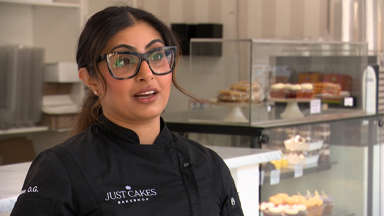In the heart of British Columbia’s vibrant culinary scene, a new generation of Asian-Canadian bakers is rising—quite literally. As we celebrate Asian Heritage Month this May, these innovative pastry chefs and bakers aren’t just creating delectable treats; they’re kneading their cultural identities into every bite, challenging perceptions and redefining what Asian baking can be.
Walking into Kouign Café in Vancouver’s Mount Pleasant neighborhood, the aroma of butter and sugar mingles with unexpected notes of pandan, black sesame, and ube. Owner and head baker Jenny Yen navigates between worlds with remarkable ease. “Growing up in Taiwan and then moving to Canada as a teenager, I always felt caught between cultures,” she explains, dusting flour from her hands. “Baking became my language—a way to express both parts of myself without having to choose.”
Yen isn’t alone. Across BC’s Lower Mainland, Asian-Canadian bakers are experiencing a creative renaissance, blending traditional European baking techniques with flavors that honor their heritage. The result? Croissants filled with red bean paste, matcha-infused sourdough, and mochi donuts that sell out within hours of hitting display cases.
This culinary fusion represents something far deeper than trendy flavors. For many of these bakers, their creations serve as edible bridges between generations and cultures. “My grandmother would never recognize some of what I make,” laughs Raymond Chen of Burnaby’s Crumb & Butter Bakery. “But when she tastes my pineapple buns with the brown sugar crust she’s known all her life—just with my small tweaks—I see recognition in her eyes. That connection is everything.”
What makes this movement particularly significant is its timing. Amid a troubling rise in anti-Asian hate crimes since 2020, these bakers find themselves serving up not just desserts but cultural understanding. Their popularity challenges stereotypes about Asian cuisines and creates spaces where cultural exchange happens naturally—over coffee and something sweet.
Social media has accelerated this cultural conversation. Instagram-worthy creations like taro-filled cruffins and sesame praline Paris-Brests have garnered these bakers tens of thousands of followers. “People message me saying they drove three hours just to try my hojicha cream puffs,” says Melissa Wong of Victoria’s Flour & Mochi. “Ten years ago, most Canadians wouldn’t have known what hojicha was. Now they’re lining up for it.”
The economic impact is substantial too. Despite launching during the pandemic, many of these Asian-influenced bakeries have thrived, creating jobs and revitalizing neighborhood commercial districts. Industry analysts point to a broader trend of consumers seeking authentic, culturally diverse food experiences—something these bakers deliver in abundance.
“What’s beautiful about baking is that it’s both science and art,” reflects James Tran, who studied engineering before opening his Richmond bakery. “The precision speaks to my analytical side, but the creative expression of blending my Vietnamese heritage with French pastry techniques—that’s where the magic happens.”
This cultural alchemy isn’t without its challenges. Some bakers report feeling pressure to exoticize their offerings to meet Western expectations of what “Asian-inspired” should mean. Others have faced criticism from traditionalists within their own communities for straying too far from authentic recipes.
“I’ve had older Chinese customers tell me I’m doing it wrong,” says Chen. “But I’ve also had them come back a week later asking for more. That’s when I know I’ve found the right balance—honoring tradition while creating something new.”
As Asian Heritage Month continues, these bakers’ stories remind us that cultural identity isn’t static but continually evolving. Their pastries serve as delicious metaphors for the Canadian experience—diverse ingredients coming together to create something greater than the sum of its parts.
The next time you bite into a yuzu-glazed croissant or a milk bread cinnamon roll, remember you’re tasting more than innovative flavors. You’re experiencing cultural storytelling at its most delicious—a narrative of belonging, creativity, and resilience baked into every flaky layer.
For those interested in exploring more cultural perspectives and trends in Canadian society, our CO24 Culture and CO24 Trends sections offer additional insights into these evolving conversations. After all, understanding each other often begins with sharing food—a universal language that speaks directly to both heart and stomach.

























